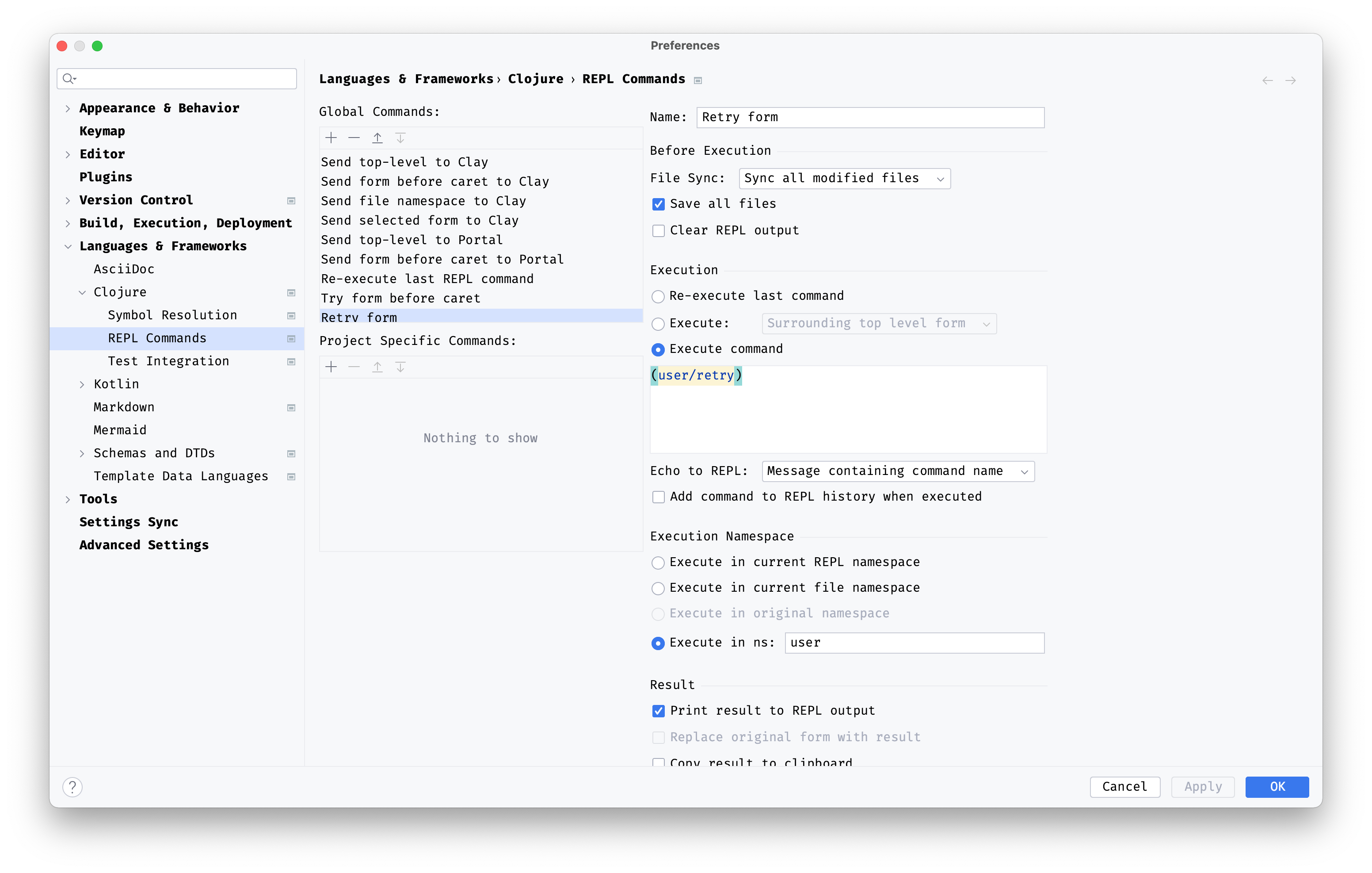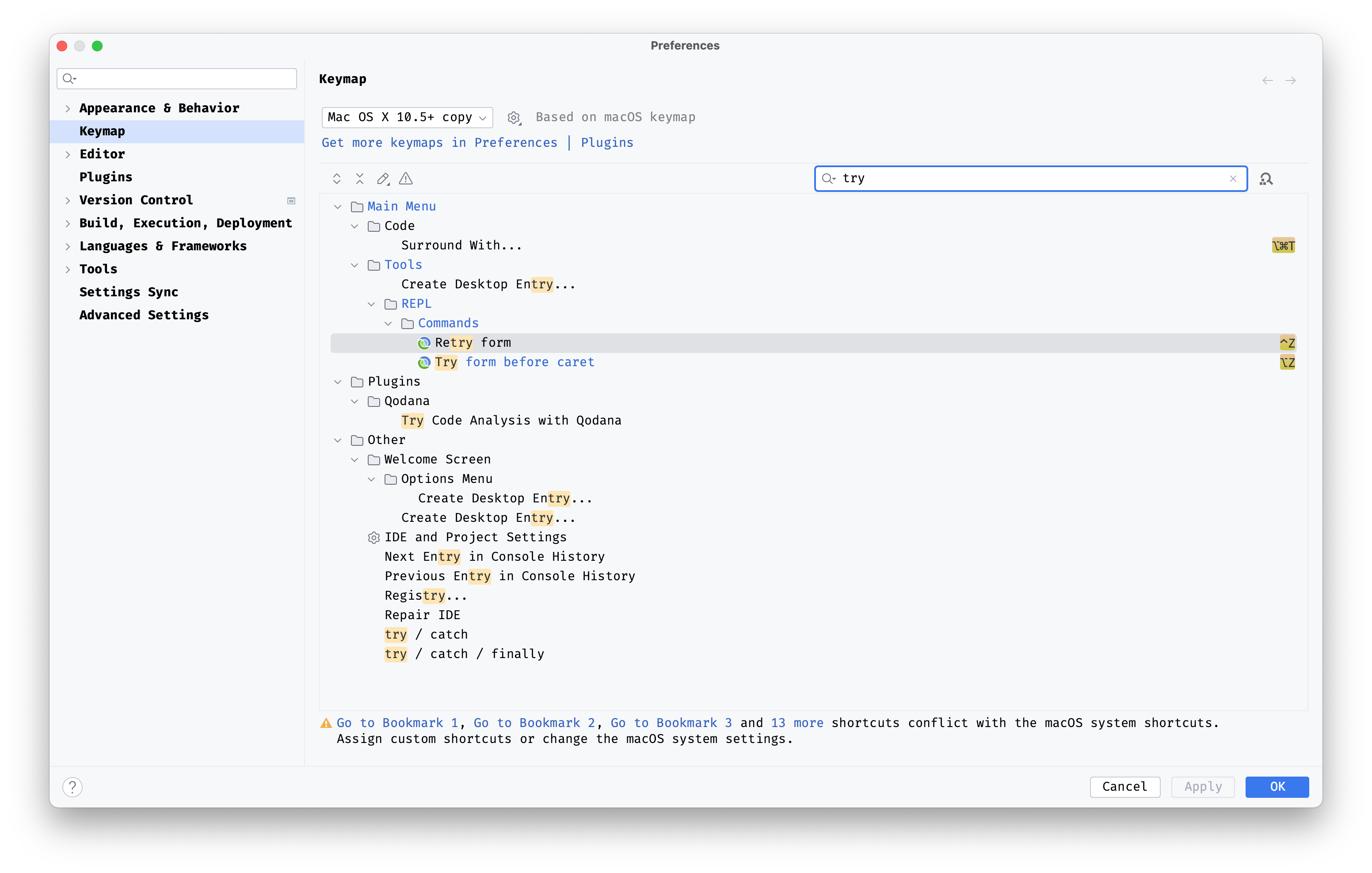One thing that I love about Clojure is that the Read-Eval-Print-Loop (REPL) enables me to redefine functions on the fly, without restarting anything. This makes trying things, making changes, and trying them again very fluid. Trying stuff, changing it, and trying it again pretty much sums up how I write code.
If at first you don’t succeed, dust yourself off and try again.
– Aaliyah
Today I’m going to share with you my favorite “try it again” tip, which is to bind keys to try something and try it again.
REPL usage
Let’s recap basic REPL usage. I can type stuff into the REPL input window and evaluate some code. Generally I don’t do that though. I’m not usually in the REPL, I’m in my source code sending forms to the REPL. To achieve that requires some essential key bindings.
| Binding | Action |
|---|---|
alt-t | Evaluate the expression before the cursor |
cmd-t | Evaluate top-level expression at the cursor |
ctrl-c | Run test under cursor |
shift-ctrl-c | Run all tests in namespace |
ctrl-c | Re-run last test action |
The Problem 😢
A common scenario I find myself in is that I set up a little bit of code to try something. Then I make some changes, and need to retry the same snippet or test. In the meantime I have navigated away and I need to either go back to the form I am interested in, or navigate to the REPL and use history to try it again. Both of these strategies work, but there is a better way!
The Solution 💡
The idea is to create a REPL command that creates a function in the user namespace. Then we can make a keybinding like “send form before caret to REPL”, and another keybinding to execute the saved function. That way even if we send other forms to the REPL, we can conveniently retry the snippet we are focused on.
Here is how I set the “try” command up: 
I use Cursive Clojure (IntelliJ). If you use a different editor, you can find instructions for creating key bound commands in the Clay setup documentation.
~form-before-caret gets replaced with code.
So if my cursor is at the end of an expression (cursor shown as _):
(+ 1 2)_
My editor will send the following code to the REPL:
(do (intern 'user 'retry (fn retry []
(+ 1 2)))
(user/retry))
This creates the retry var in the user namespace (user/retry), and assigns it to a function that will run the code I am interested in.
It is worth considering a few questions about namespaces at this point. Which namespace will the command execute in? How can user/retry “see” variables in the currently edited namespace?
The command will execute in the namespace of the file I am editing, because I configured the command to do so through Cursive. The function is created in the current namespace, because (fn retry [] (+ 1 2)) is eagerly evaluated as an argument to intern. Because the function is created in the current namespace, x is resolved correctly. user/retry can be invoked from any namespace by the fully qualified name of the var user/retry.
Here is how I set the “retry” command which simply invokes (user/retry): 
And here are the keybindings for the commands I use: 
I’ve bound alt-z to “try form before caret” and ctrl-z to “retry”.
Now let’s take it for a spin. Here is some code I’ve been working on; I’m drawing a heart shape.
(def heart-path
"M 12.0 7.2 C 10.5 5.6 8.1 5.2 6.3 6.7 C 4.5 8.1 4.2 10.6 5.7 12.4 L 12.0 18.3 L 18.3 12.4 C 19.7 10.6 19.5 8.1 17.7 6.7 C 15.8 5.2 13.4 5.6 12.0 7.2 Z")
"#'blog.try-again/heart-path"
This shape comes from svg-paths by @nandafyi.
I’ll visualize it in an SVG image:
(defn svg [& body]
(into ^{:kindly/kind :kind/hiccup}
[:svg {:width 256
:height 256
:viewBox [0 0 24 24]
:xmlns "http://www.w3.org/2000/svg"}]
body))
"#'blog.try-again/svg"
The heart path goes into an SVG element:
(defn heart []
[:path {:fill "green"
:d heart-path}])
"#'blog.try-again/heart"
And to see what it looks like I’ll make a “rich comment block”:
(comment
(svg (heart)))
The comment block allows me to conveniently send the expression (svg (heart)) to the REPL, and of course we’ll use my new “try form before caret” on it.
(svg (heart))
Now I can navigate throughout my code base, making changes and fixes, and seeing the effect is just one keystroke away with “retry”:
(defn heart []
[:path {:fill "red"
:d heart-path}])
"#'blog.try-again/heart"
(svg (heart))
Setting up the command to sync all changes before executing makes it easy to test changes as I go, often I can rely on syncing instead of sending updates to the REPL individually.
Special thanks to @chrishouser and @IPmonger@hachyderm.io for dedicating a session of LiSP reading group to improving my workflow with try/retry.